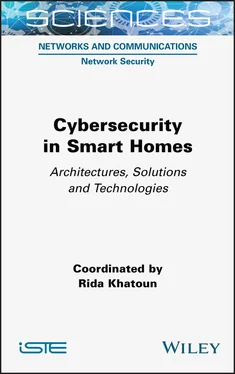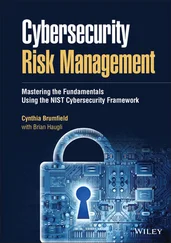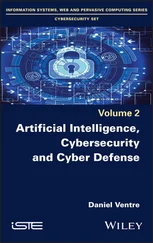1 Cover
2 Title Page SCIENCES Networks and Communications, Field Director – Guy Pujolle Network Security , Subject Head – Rida Khatoun
3 Copyright First published 2022 in Great Britain and the United States by ISTE Ltd and John Wiley & Sons, Inc. Apart from any fair dealing for the purposes of research or private study, or criticism or review, as permitted under the Copyright, Designs and Patents Act 1988, this publication may only be reproduced, stored or transmitted, in any form or by any means, with the prior permission in writing of the publishers, or in the case of reprographic reproduction in accordance with the terms and licenses issued by the CLA. Enquiries concerning reproduction outside these terms should be sent to the publishers at the undermentioned address: ISTE Ltd 27-37 St George’s Road London SW19 4EU UK www.iste.co.uk John Wiley Sons, Inc 111 River Street Hoboken, NJ 07030 USA www.wiley.com © ISTE Ltd 2022 The rights of Rida Khatoun to be identified as the author of this work have been asserted by him in accordance with the Copyright, Designs and Patents Act 1988. Any opinions, findings, and conclusions or recommendations expressed in this material are those of the author(s), contributor(s) or editor(s) and do not necessarily reflect the views of ISTE Group. Library of Congress Control Number: 2022931518 British Library Cataloguing-in-Publication Data A CIP record for this book is available from the British Library ISBN 978-1-78945-086-6 ERC code: PE6 Computer Science and Informatics PE6_2 Computer systems, parallel/distributed systems, sensor networks, embedded systems, cyber-physical systems PE7 Systems and Communication Engineering PE7_8 Networks (communication networks, sensor networks, networks of robots, etc.)
4 1 Home Automation Solutions for SecureWSN
1.1. Introduction
1.2. Background
1.3. Design decisions
1.4. Implementation
1.5. Evaluation of HAIFA
1.6. Summary and conclusions
1.7. Acknowledgements
1.8. References
5 2 Smart Home Device Security: A Survey of Smart Home Authentication Methods with a Focus on Mutual Authentication and Key Management Practices
2.1. Introduction
2.2. Smart home – introduction and technologies
2.3. Smart home security
2.4. Smart home authentication mechanisms
2.5. A primer on mutual authentication and key management terminologies
2.6. Mutual authentication in smart home systems
2.7. Challenges and open research issues
2.8. Conclusion
2.9. References
6 3 SRAM Physically Unclonable Functions for Smart Home IoT Telehealth Environments
3.1. Introduction
3.2. Related literature
3.3. System design considerations
3.4. Silicon physically unclonable functions(PUF)
3.5. Convolutional encoding and Viterbi decoding the SRAM words
3.6. CMOS SRAM PUF construction
3.7. Algorithms for issuing CRP
3.8. Security of PUF-based IoT devices
3.9. Conclusions
3.10. Acknowledgements
3.11. References
7 4 IoT Network Security in Smart Homes
4.1. Introduction
4.2. IoT and smart home security
4.3. IoT network security
4.4. Prevailing standards and initiatives
4.5. Conclusion
4.6. References
8 5 IoT in a New Age of Unified and Zero-Trust Networks and Increased Privacy Protection
5.1. Introduction
5.2. Internet of Things
5.3. IoT security and privacy challenges
5.4. Literature review
5.5. Security and privacy protection with a zero-trust approach
5.6. Case study: secure and private interactive intelligent conversational systems
5.7. Discussion
5.8. Conclusion
5.9. Acknowledgements
5.10. References
9 6 IOT, Deep Learning and Cybersecurity in Smart Homes: A Survey
6.1. Introduction
6.2. Problems encountered
6.3. State of the art
6.4. IoT architecture
6.5. IoT security
6.6. Artificial intelligence, machine learning and deep learning
6.7. Smart homes
6.8. Anomaly detection in smart homes
6.9. Conclusion
6.10. References
10 7 sTiki: A Mutual Authentication Protocol for Constrained Sensor Devices
7.1. Introduction
7.2. Definitions and history of IoT
7.3. IoT-related security concerns
7.4. Background knowledge for sTiki
7.5. The sTiki protocol
7.6. sTiki’s evaluation
7.7. Summary and conclusions
7.8. Acknowledgements
7.9. References
11 List of Authors
12 Index
13 End User License Agreement
1 Chapter 1Table 1.1. Comparison between MQTT and CoAP Table 1.2. Rule automation for available log types Table 1.3. Automation test procedure
2 Chapter 2Table 2.1. Summary of security threats and challenges for a smart home Table 2.2. Summary of protocols across different IoT layers (Kalla et al. 2020) Table 2.3. Matrix of security architectures and security goals (Authentication (...Table 2.4. Stages of defining an authentication protocol for IoT (Ferrag et al. ...Table 2.5. IoT authentication schemes (El-Hajj et al. 2019) Table 2.6. Examples of smart home authentication proposals Table 2.7. Examples of mutual authentication schemes
3 Chapter 3Table 3.1. The Algorithm #1 maximum intra Hamming distance and inter Hamming dis...Table 3.2. The Algorithm #2 maximum intra Hamming distance and inter Hamming dis...Table 3.3. The Algorithm #3 maximum intra Hamming distance and inter Hamming dis...
4 Chapter 5Table 5.1. Overview of selected IoT operating Systems (OS)
5 Chapter 6Table 6.1. Layers of IoT Table 6.2. Description of different neural network algorithms
6 Chapter 7Table 7.1. sTiki size according to size utility [Byte]
1 Chapter 1Figure 1.1. The relationship between all components of a SecureWSN (Schmitt 2019...Figure 1.2. CoMaDa and WebMaDa bi-directional communication (Weber 2020) Figure 1.3. MAPE-K model from IBM (Kephart and Chess 2003). For a color version ...Figure 1.4. High level architecture of the HAIFA model. For a color version of t...Figure 1.5. HAIFA startup sequence Figure 1.6. Adding gateways and actuators to HAIFA Figure 1.7. Overview of HAIFA hardware. For a color version of this figure, see ...Figure 1.8. One iteration of the Automation-Worker cycle Figure 1.9. HAIFA configuration and management endpoints Figure 1.10. HAIFA ZigBee gateway with communication flows Figure 1.11. Database schema of the HAIFA CoMaDa part Figure 1.12. Database schema of the HAIFA WebMaDa part Figure 1.13. HAIFA interfaces and core classes Listing 1.1. Hi-Module life-cycle methods Listing 1.2. HA Module – node-datum mapping update handler Listing 1.3. Hi-Module - create node-datum mappings Figure 1.14. Actuators, commands, and arguments Figure 1.15. Rules and conditions Listing 1.4. The gateway interface Listing 1.5. Implementation of the Automation-Worker Listing 1.6. The storage interface Listing 1.7. The PostgreSQL storage implementation – fetch all rules Listing 1.8. HAHttpController’s registration of the HA-Module Figure 1.16. HAIFA’sadministration frontendin CoMaDa Figure 1.17. Rule log visualization of the administration interface Figure 1.18. Rule creation – AngularJS widgetandsub-widgets. For a color version...Listing 1.9.
Читать дальше












